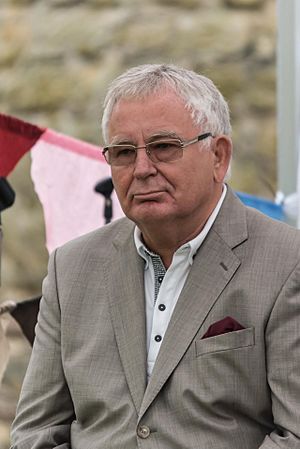Tiit Vähi facts for kids
Quick facts for kids
Tiit Vähi
|
|
|---|---|

Vähi in 2016
|
|
| 11th Prime Minister of Estonia | |
| In office 17 April 1995 – 17 March 1997 |
|
| President | Lennart Meri |
| Preceded by | Andres Tarand |
| Succeeded by | Mart Siimann |
| 2nd Prime Minister of the Interim Government | |
| In office 29 January 1992 – 21 October 1992 |
|
| President | Arnold Rüütel as Chairman of the Supreme Council Lennart Meri |
| Preceded by | Edgar Savisaar |
| Succeeded by | Mart Laar as Prime Minister |
| Personal details | |
| Born | 10 January 1947 Kaagjärve Parish, Valga County, Estonia |
| Political party | Estonian Coalition Party |
| Alma mater | Tallinn Technical University |
Tiit Vähi (born 10 January 1947) is an Estonian politician. He served as the Prime Minister of Estonia from 1995 to 1997. Before that, he was also the acting Prime Minister for several months in 1992. This happened during a time when Estonia was transitioning to full independence.
Contents
Early Life and Career
Tiit Vähi was born in Kaagjärve Parish, Estonia. He studied engineering at the Tallinn Technical University. After graduating, he worked in important management roles at the Valga Trucking Company until 1992.
Helping Estonia Gain Independence
During Estonia's journey to become an independent country again, Tiit Vähi played a big part. He helped organize the Estonian Popular Front, which was a group working for independence. He led their local committee in Valga County.
In 1989, he became the Minister of Transport and Communications. He held this job until January 1992. As Transport Minister, he built strong connections with transport ministries in the Nordic countries. He also improved relationships with the other two Baltic States on transport matters. A major achievement was taking control of Estonia's airports, railways, and seaports from Moscow and giving it to Estonian authorities.
Special Role in North-Eastern Estonia
After Estonia regained its independence in 1991, Vähi was given a special job. He became the government's representative for north-eastern Estonia. This area had many people of Russian background.
First Time as Prime Minister (1992)
On 29 January 1992, Tiit Vähi became the second Prime Minister of Estonia after the Soviet Union era. He took over from Edgar Savisaar.
Changing Estonia's Economy
During his first time as prime minister, Vähi started a huge plan. He wanted to change Estonia's economy from being controlled by the government to a free market economy. This meant businesses would have more freedom.
His government also introduced Estonia's own money, the Kroon, in June 1992. He also created the Estonian Privatisation Agency. This agency helped sell government-owned businesses to private companies.
When he became prime minister in the transition government, it was agreed that Vähi would not run in the parliamentary elections. These elections happened on 20 September 1992.
Second Time as Prime Minister (1995-1997)
In 1993, Tiit Vähi was chosen as the Chairman of the Estonian Coalition Party. In March 1995, the parliamentary elections were won by a group called the KMÜ coalition. This group included the Estonian Coalition Party and the People's Union of Estonia Parties.
Forming a New Government
Because he was the leader of the Estonian Coalition Party, President Lennart Meri asked Vähi to form a new government. He became Prime Minister for the second time. He put together a government with the KMÜ and the Estonian Centre Party. This new government officially started on 17 April 1995.
Challenges and Resignation
His second time as prime minister was quite difficult. On 11 October 1995, several ministers left the government. This caused the Estonian Centre Party to leave the coalition.
On 7 November 1995, Vähi formed the government again. This time, he worked with the Estonian Reform Party. However, this partnership did not last long. On 20 November 1996, six ministers, including the Foreign Minister Siim Kallas, resigned. This ended the cooperation between the Coalition Party and the Reform Party.
On 1 December 1996, Vähi changed the government one more time. This time, he only used members from his own party. This made it harder for his government to stay in power. On 7 February 1997, Vähi survived a vote where people tried to remove him from office. The vote was very close, 46 to 45.
Feeling pressure from his own party, he decided to resign on 25 February 1997. Three days later, on 27 February, President Lennart Meri named Mart Siimann as the new prime minister.
By 2001, the Estonian Coalition Party, which Vähi had helped create, was no longer active. Today, Tiit Vähi is a member of the Reform Party, which supports free markets. He is not active in politics anymore and focuses on his business career. He has shared his opinion that Estonia should improve its relationship with Russia.

